The Bavarian car maker officially revealed the seventh generation 2017 BMW 5-Series. The new premium class sedan is 100 kilograms lighter and due to many technical innovations even more controllable than before. New BMW 5-Series 2017 Sedan represents a further step towards autonomous ride. From standstill to 210 km / h, the vehicle can, if desired, perform tasks such as acceleration, braking and steering, instead of the driver.
World premiere of the new 2017 BMW 5-Series Sedan/Saloon
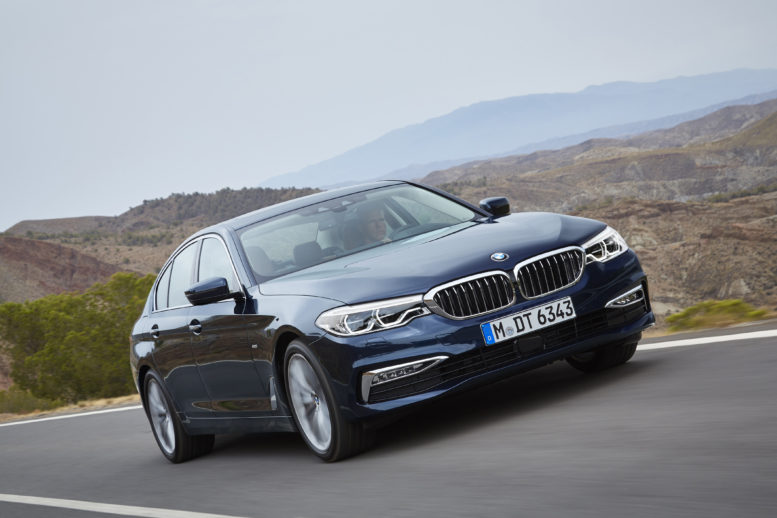
2017 BMW 5-Series Sedan release date: February 11th, 2017
This is far from being all that’s new in the seventh generation BMW 5-Series, with the release date in February next year. The new generation of the BMW 5 Series will step into big shoes. In the first six generations of predecessors, more than 7.6 million BMW 5 Series have been sold worldwide. At the presentation of the newcomer, Harald Krüger, Chairman of the Board at BMW AG, said that BMW 5 series now points the way to the future, which will focus on technology, emotion and digitization.
Lighter than before, with record braking drag coefficient
Bavarians are still representing the BMW 5-Series as a business sedan, but did not abandon the famous BMW EfficientLightweight design concept with the increased use of aluminum and high strength steels. The total weight of 4.93 meter long vehicle with a drag coefficient (Cd = 0.22) is reduced by up to 100 kilograms in comparison with the current model. This also means that the new 2017 5-series is the most aerodynamic BMW of all times.
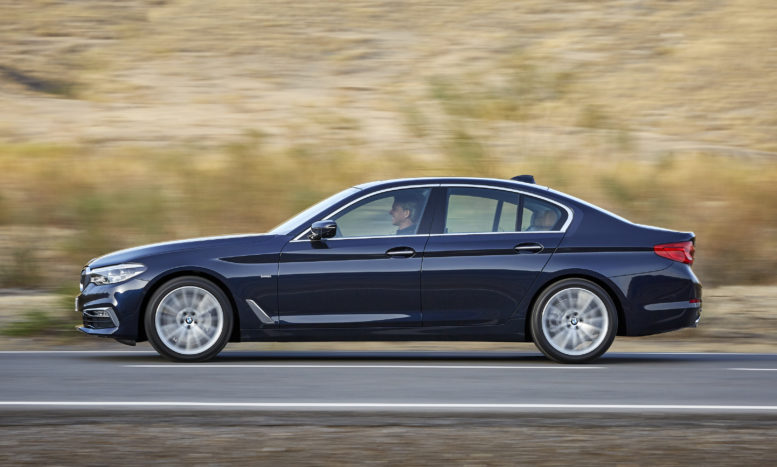
2017 BMW 5-Series is 3 centimeters longer and up to 100 kilograms lighter compared to the predecessor.
This result also puts it in the top of its vehicle class and beats the main competitor Mercedes E-Class record value by 0.01. It is surprising that BMW managed to achieve this great result without relying on the sloping rear end, a trick that is most effectively utilized by modern Mercedes sedans.
Slightly larger in all dimensions
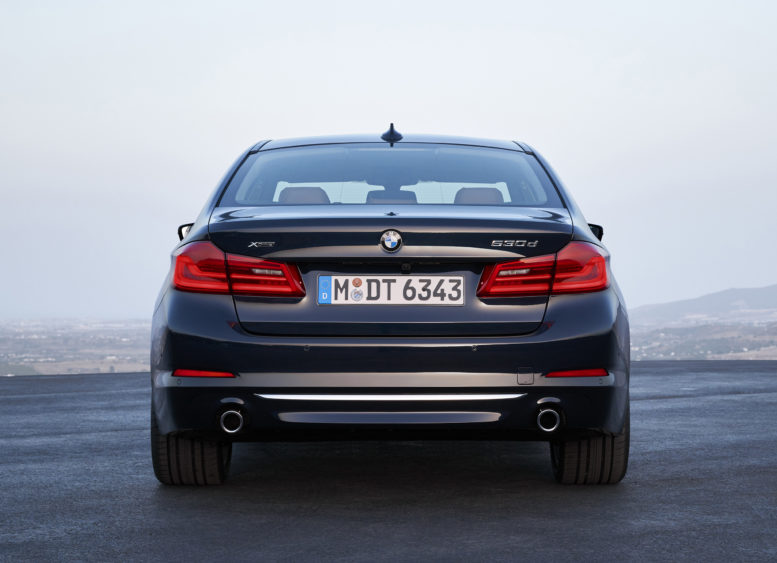
New BMW 5-Series rear view: slightly wider and higher than predecessor.
BMW 5 series is three centimeters longer and slightly wider and higher than the car, that was sent to well-deserved rest after seven years. Measurement increment in theory means about the same, average spacious cabin and ten liters larger trunk, with 530-liters of volume.
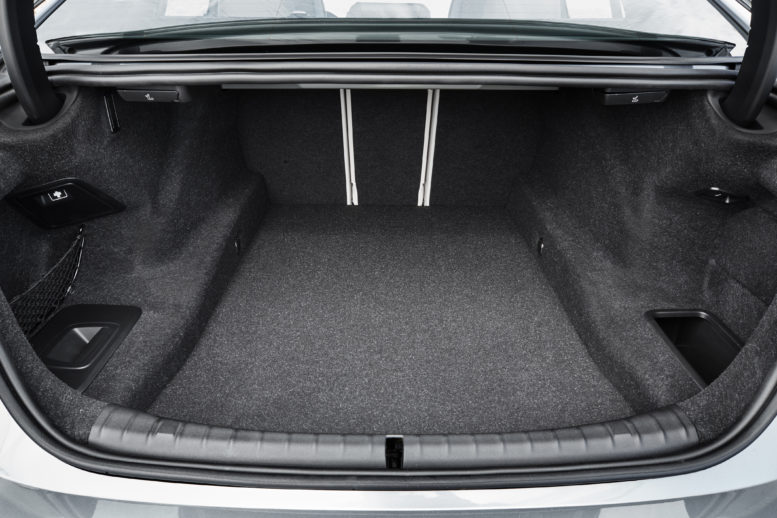
Trunk increased for 10 liters, luggage compartment volume is now 530 liters.
In the interests of further improvement in driving dynamics, the engineers redesigned the chassis. The center of gravity is now lower, weight between the axles is distributed evenly. Lightweight body prides itself with increased torsional rigidity. 2017 BMW 5-Series will offer a variety of chassis options, such as the Integral Active Steering or four-wheel steering, for the first time available with lowered sports suspension, or in combination with four-wheel drive xDrive.
2017 BMW 5-Series is filled with assistant systems
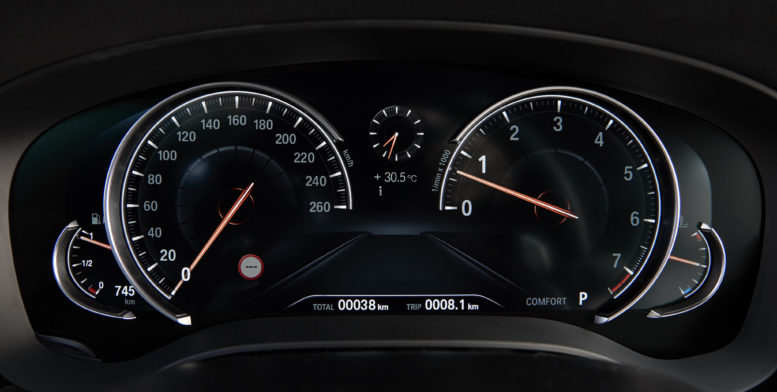
Behind the dashboard 2017 BMW 5-Series hides an army of smart electronic assistants and systems.
New BMW 5-Series 2017 will have the most numerous “band” of assistance systems installed, to help the driver in critical situations such as traffic jams or monotonous bumper to bumper driving. BMW 5-Series has a serial stereo camera, which is connected with additional radar and ultrasonic sensors to monitor the area around the vehicle.
Among the innovations, in addition to collision avoidance and the cross traffic warning system, there is an assistant when changing lane and assistant to maintain the lane with active protection against side impact. The latter keeps an eye on the driving lane lines and the area around the vehicle and actively helps the driver avoid a threatening collision with intervention in the steering.
Promising semi-autonomous driving from 0-210 km/h
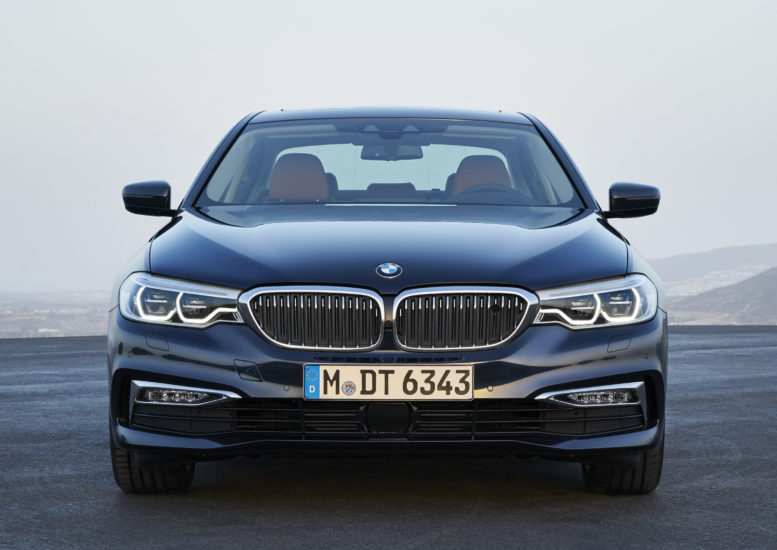
BMW 5-Series now semi-autonomously drives, brakes, steers and accelerates up to a speed of 210 kilometers per hour.
Thanks to the various driver assistance systems, such as speed control (ACC), lane preservation and control of the steering wheel, the new BMW 5-Series will be able to drive itself from standstill to 210 km/h. If desired, it will perform tasks, such as acceleration, braking and steering, instead of the driver. An Auto Start Stop function now adjusts its reactions depending on the route and traffic conditions.
The 2017 BMW 5 Series accepted the challenge of modern times and has become, with the help of large-scale digitization, the smartest car of its class. A large part of its electronic brain is designed to realizing the promise of a secure execution of a semi-autonomous driving.
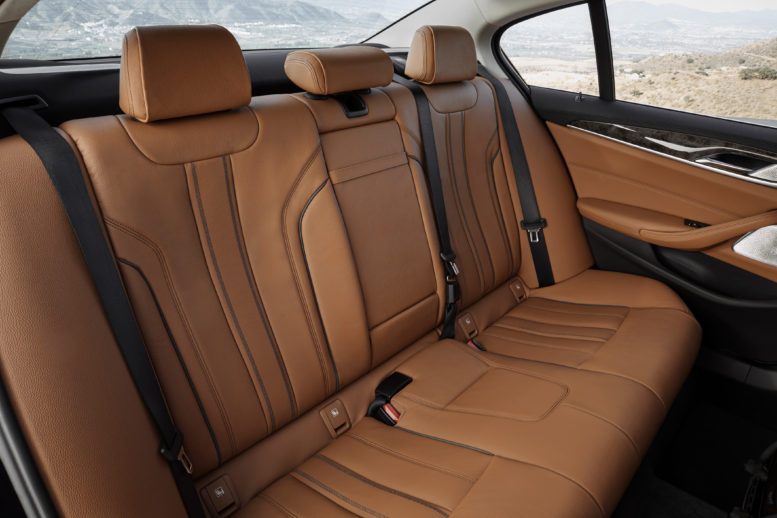
2017 BMW 5-Series rear bench.
While rivals such as the Mercedes E and the Volvo S90, require the driver’s hands on the wheel at any time during the autonomous piloting, BMW 5 Series using similar technology, supported by a stereo camera, radar and ultrasonic sensors allow the 30-second intervals when the driver can leave the driving to the artificial intelligence.
The 2017 BMW 5-Series Cabin – a scaled 7-Series
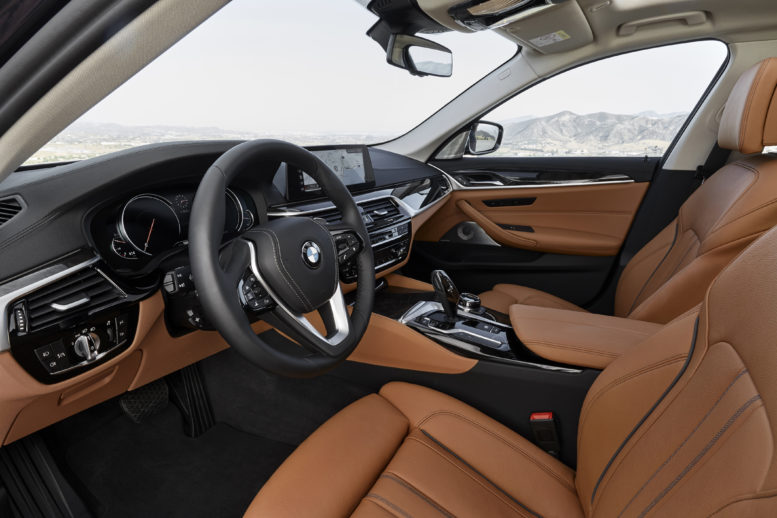
The cabin in new BMW 5-Series is a combination of touch screen surfaces and conventional knobs.
Sporty elegance of the cockpit in the architectural sense does not deviate from the seen and experienced in the 7-Series. At the same time, 5-Series presents a proven combination of touch sensitive surfaces (heated seats, changing of radio stations, the top of the round controller on the right side of the center console …) and classic switches . Volume control of the audio system and cabin temperature adjustment will still belong to the conventional rotary knob.
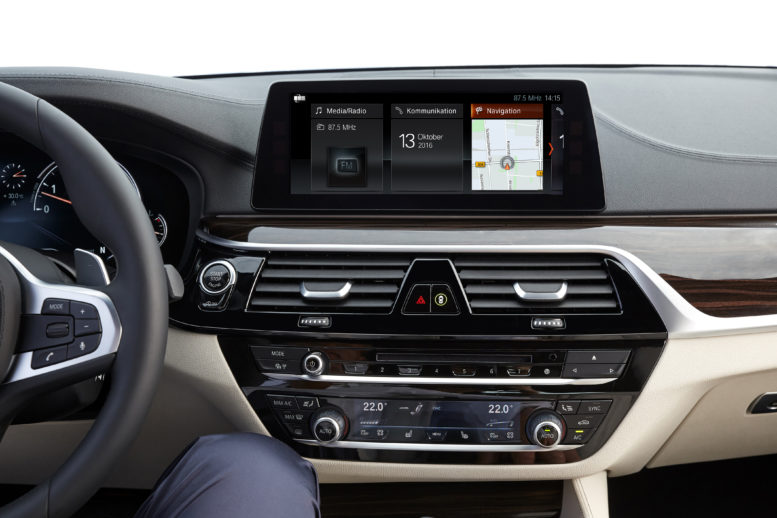
2017 BMW 5-Series center console with 10,25-inch screen for navigation, telephone, radio and other important vehicle information.
They improved the iDrive Controller. 10.25-inch screen displays navigation, telephone and entertainment information and other features of the vehicle. The system can optionally be operated with gestures. Large on-screen icons can be assigned as desired. Color BMW Head-Up Display now shows information, such as traffic signs, mobile phone data, radio, navigation instructions, assistance system warnings. It now covers 70 percent more surface area than previously.
Comfort and safety – concern for the welfare of the driver is extraordinary, including LED headlights
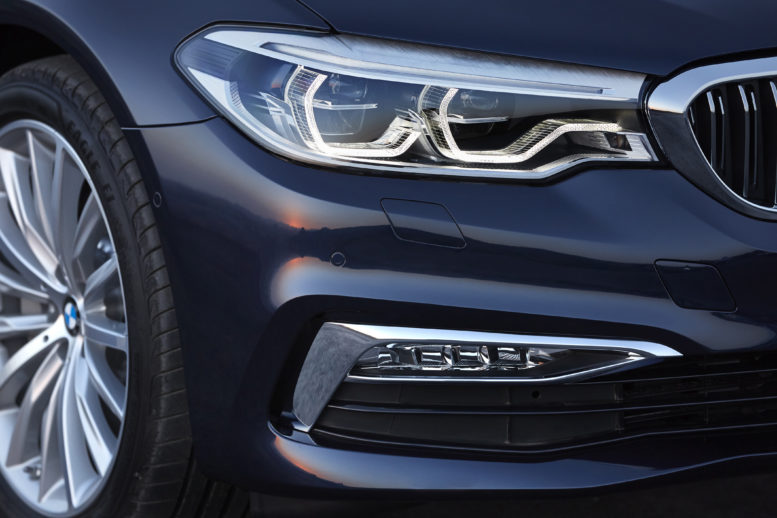
Serial LED headlights in BMW 5-Series 2017.
BMW 5-Series 2017 will be armed with a serial LED headlights with auto-adjustable high beam headlights, and on the list of additional equipment there is even more powerful LED alternative with the adaptable beam and the 500-meter outreach.
And, the care for comfort is only just starting. Special silencers are built into the roof panels for the purpose of sound reduction, while a a special acoustic windshield will also have the similar effect of reducing interfering decibels.
Priceless 7-Series gifts: interactive key with display
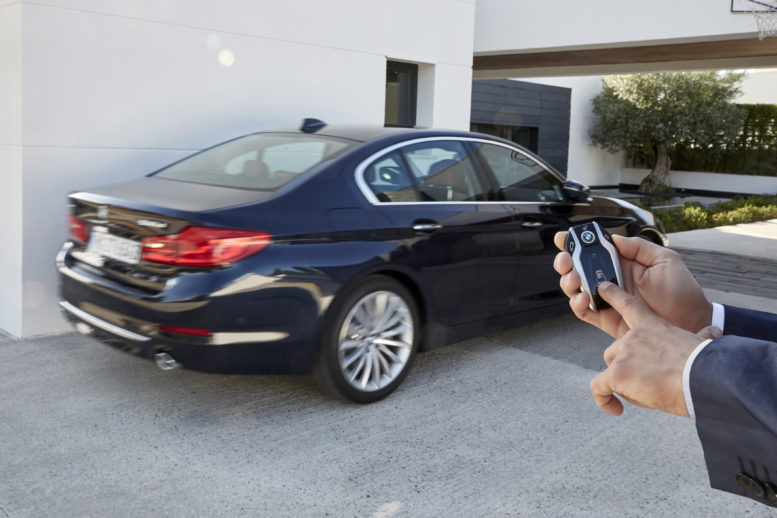
The new 5-Series will inherit the interactive key with display from 7-Series.
Having larger and more prestigious sister is great in many ways. Among other things, the 5-Series will inherit the interactive key with display, which is touch sensitive. A completely autonomous parking of the vehicle will be possible through the key.
Digital parking reservation and payment
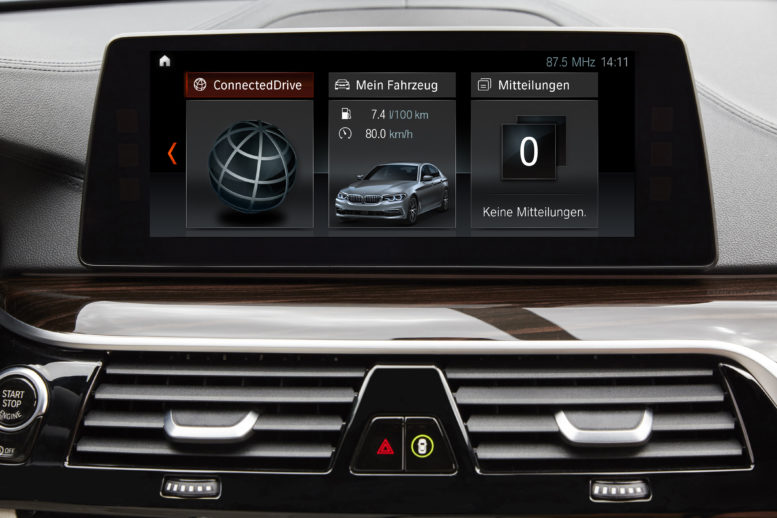
The Digital Services from BMW 5-Series ConnectedDrive offer you a wide range of useful features.
A lot of new things are in the field of ConnectedDrive connectivity. ParkNow digital technology allows booking and payment of parking and retrieving information for on-street parking. Smart parking spaces search feature and additional parking assistant feature enable the detection of empty parking spaces. When the system finds an empty place, automatically parks the vehicle.
Microsoft Exchange account users with Microsoft Office 365 allows synchronization of email, calendar entries and contacts, which can then be edited in the vehicle. Like the 7 Series, BMW 5 Series 2017 now also allows parking at a distance using the remote control parking, without a driver in the vehicle.
Personal Digital mobility Assistant: Navigation connected with drivers personal agenda
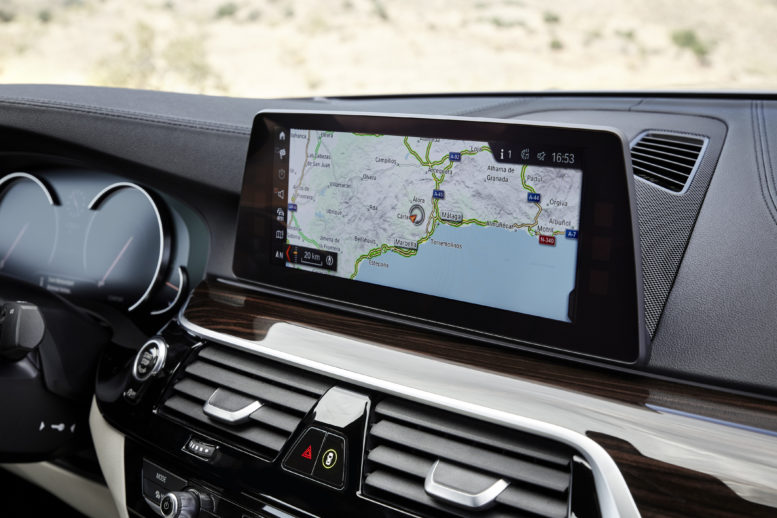
In 5-Series, BMW connected navigation targets and arrival times with drivers personal agenda.
Personal Digital mobility Assistant, Bavarians named it BMW Connected, together with additional services enables drivers to review their information related to mobility. Relevant content, such as the upcoming navigation targets and expected arrival time, recorded in their personal agenda, is transferred from the smartphone to the vehicle and displayed on the personalized screen. Remote 3D View function allows drivers to see a three-dimensional view of the area around the vehicle on a smartphone.
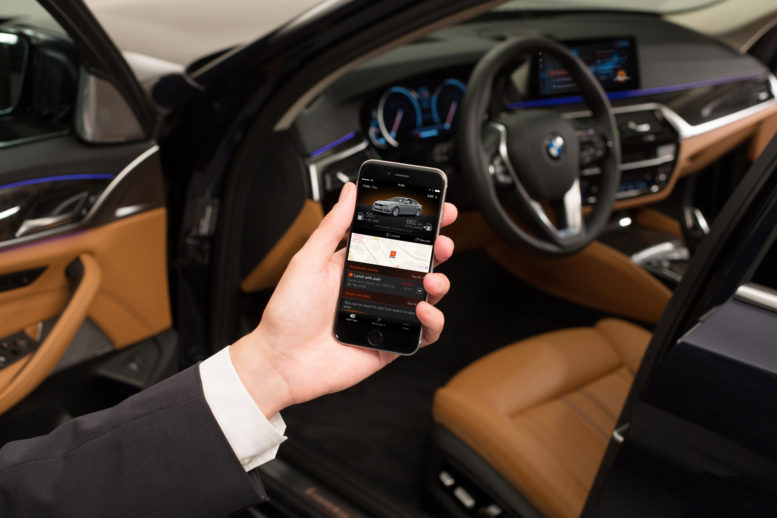
Remote 3D View function in BMW 5-Series 2017 allows drivers to see a 3D view of the area around the vehicle on a smartphone.
New and renewed BMW TwinPower Turbo engines
All engines in the BMW 5 series belong to a new, modular family of power units in the context of BMW EfficientDynamics. The BMW TwinPower Turbo technology is aimed at the entire drive range. On average, the new engines are up to 12 percent more economical than for the previous generation. From the arrival on the market, two diesel and gasoline engines will be available, in connection with either rear-wheel drive or xDrive all-wheel drive system.
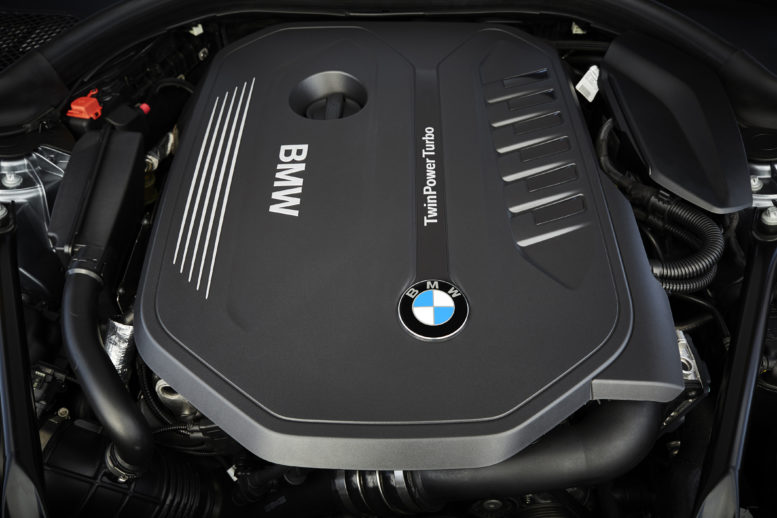
2017 BMW 5-Series TwinPower Turbo engine.
The new is 2.0-liter 4-cylinder engine in the BMW 530i, which develops a maximum torque of 350 Nm and maximum power output of 252 hp. Its combined fuel consumption is 5.4 l/100 km, which represents 126 g CO2 per kilometer. That means an 11 percent reduction compared to the predecessor. Acceleration from 0 to 100 km/h takes 6.2 seconds and a top speed of 250 km/h.
At launch, the BMW 540i will be the most powerful engine with an output of 340 hp. This 3.0-liter straight-six is developing 450 Nm of torque, fuel consumption is 6.5 l/100 km, CO2 emissions of 150 g/km. The acceleration from 0 to 100 km/h of the xDrive version takes 4.8 seconds, about as fast as the BMW M5 two generations ago.
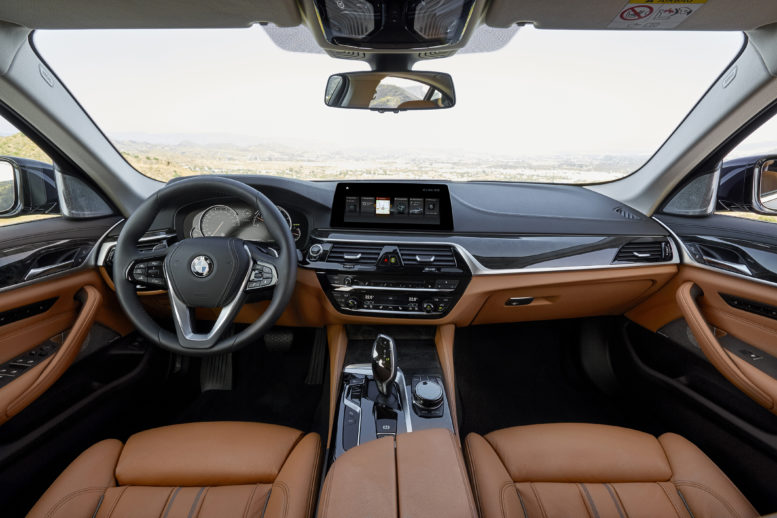
The new BMW 5-Series interior follows the heritage of the brand: the center console is turned towards the driver.
BMW 520d and BMW 530d have the new diesel engine. 4-cylinder diesel engine in the BMW 520d develops 190 hp and maximum torque of 400 Nm. Fuel consumption, according to BMW, amounts to 4.1 l/100 km and CO2 emissions are 108 g/km with manual gearbox or 4.0 l/100 km and 107 g/km with an 8-speed automatic transmission with Steptronic.
BMW 530d has a 6-cylinder engine with 265 hp and maximum torque of 620 Nm. This means that it is significantly more powerful than the comparable predecessor model, and about 13 percent more economical than its predecessor.
BMW 530E iPerformance Plug-in Hybrid and V8 coming soon
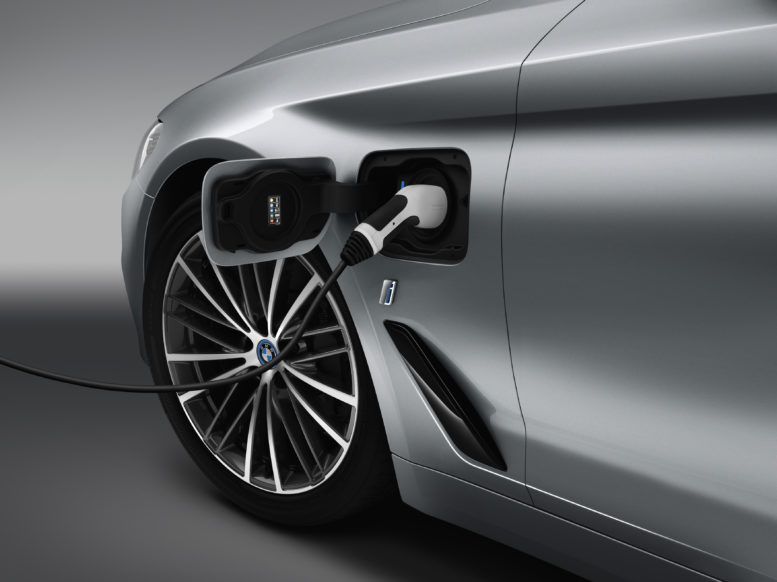
2017 BMW 530e iPerformance plug-in hybrid eDrive
Shortly after arriving on the market, the offer will be enriched by three engine variants. 2-liter 4-cylinder diesel engine with 190 hp will be available in BMW 520d EfficientDynamics Edition, with 8-speed Steptronic automatic transmission. Its CO2 emissions are 102 g/km, while BMW claims an average fuel consumption of only 3.9 l/100 km.
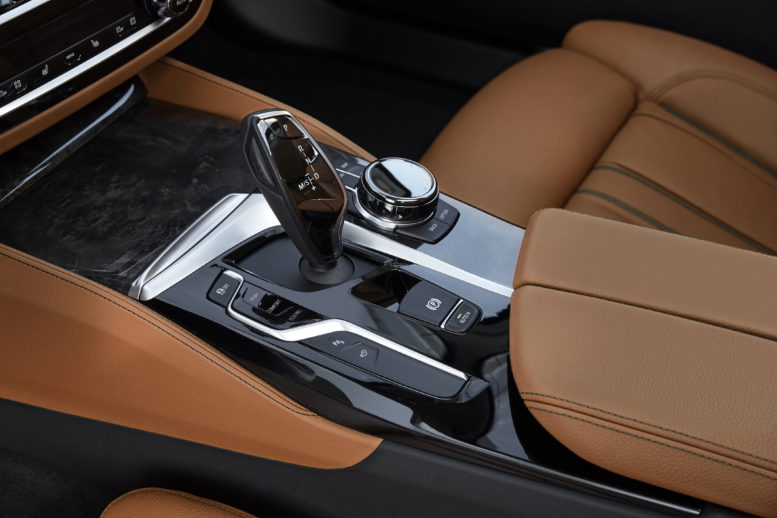
8-speed automatic transmission with Steptronic fits neatly into the interior.
In March 2017, BMW 530E iPerformance comes on the market. This plug-in hybrid combines an electric motor and a 4-cylinder gasoline engine. Promised CO2 emissions are 46 g/km, an average fuel consumption of 2.0 l/100 km, and the total system power of 252 hp.
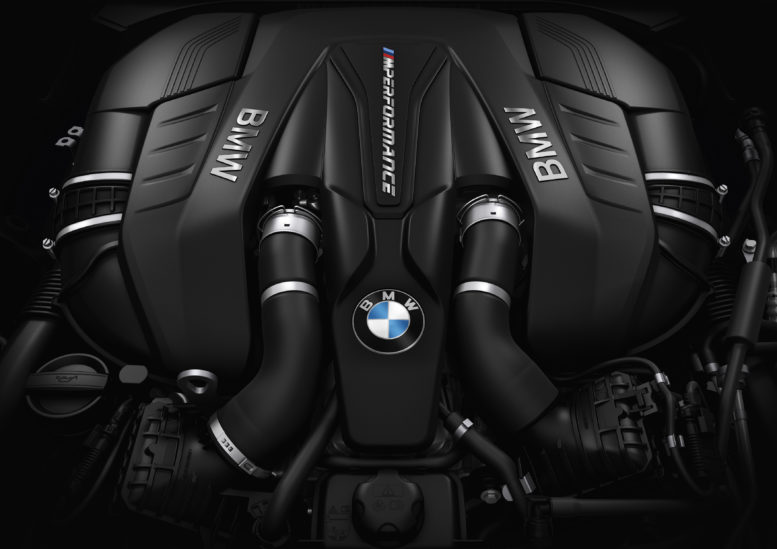
2017 BMW M550 xDrive engine: 4.4-liter V8 with 462 hp.
Also in March 2017, BMW M550 xDrive will be presented to the public. Namely, at least for now, this version is the sports pinnacle of the new BMW 5 Series 2017. Its V8 engine develops 462 hp and 650 Nm of torque. The acceleration from 0 to 100 km/h is 4.0 seconds.
2017 BMW 5-Series technical specifications
Dimensions
Business sedan, 5 seats, 4 doors.
Length: 4,936 mm.
Width: 1,868 mm.
Height (unladen): 1,479 mm.
Wheelbase: 2,975 mm.
Track, front/rear: 1605/1630 mm.
Ground clearance: 144 mm (xDrive 139 mm).
Turning circle: 12.05 meters (xDrive 12.22 meters).
Fuel tank capacity: 68 liter (gasoline), 66 liter (diesel).
Luggage compartment capacity: 530 liter.
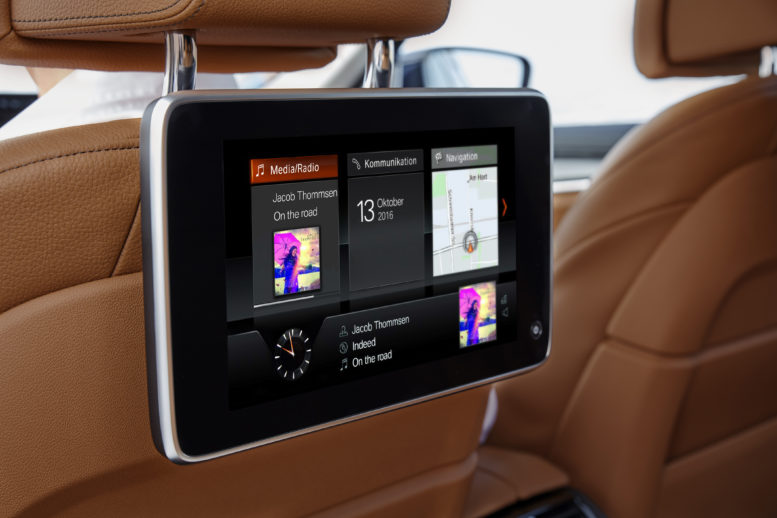
2017 BMW 5-Series rear seat display.
Model variants at market launch on 11 February 2017:
BMW 530i/BMW 530i xDrive
Four-cylinder petrol engine, eight-speed Steptronic transmission.
Capacity: 1,998cc.
Maximum power output: 252 hp at 5,200 – 6,500 rpm.
Maximum torque: 350 Nm (258 lb-ft) at 1,450 – 4,800 rpm.
Top speed: 250 km/h.
Acceleration (0–100 km/h [62 mph]): 6.2 s (6.0 s).
Fuel consumption, combined: 5.4 l/100 km [52.3 mpg imp] (5.7 l/100 km [49.6 mpg imp])*.
CO2 emissions, combined: 126 g/km (133 g/km).
BMW 540i/BMW 540i xDrive
Six-cylinder petrol engine, eight-speed Steptronic transmission.
Capacity: 2,998cc.
Maximum power output: 250 kW/340 hp at 5,500 – 6,500 rpm.
Maximum torque: 450 Nm (332 lb-ft) at 1,380 – 5,200 rpm.
Top speed: 250 km/h.
Acceleration (0–100 km/h [62 mph]): 5.1 s (4.8 s).
Fuel consumption, combined: 6.5 l/100 km [43.5 mpg imp] (6.7 l/100 km [42.2 mpg imp])*.
CO2 emissions, combined: 150 g/km (156 g/km).
BMW 520d/BMW 520d xDrive
Four-cylinder diesel engine, six-speed manual gearbox/eight-speed Steptronic transmission (xDrive: eight-speed Steptronic transmission).
Capacity: 1,995cc.
Maximum power output: 140 kW/190 hp at 4,000 rpm.
Maximum torque: 400 Nm (295 lb-ft) at 1,750 – 2,500 rpm.
Top speed: 238 km/h (xDrive 232 km/h).
Acceleration (0–100 km/h [62 mph]): 7.7 s/7.6 s (7.6 s).
Fuel consumption, combined: 4.1 l/100 km [68.9 mpg imp] / 4.0 l/100 km [70.6 mpg imp] (4.2 l/100 km [67.3 mpg imp])*.
CO2 emissions, combined: 108 g/km / 107 g/km (112 g/km).
Model variants from March 2017:
BMW 530d/BMW 530d xDrive
Six-cylinder diesel engine, eight-speed Steptronic transmission.
Capacity: 2,993cc.
Maximum power output: 265 hp at 4,000 rpm.
Maximum torque: 620 Nm (457 lb-ft) at 2,000 – 2,500 rpm.
Top speed: 250 km/h.
Acceleration (0–100 km/h [62 mph]): 5.7 s (5.4 s).
Fuel consumption, combined: 4.5 l/100 km [62.8 mpg imp] (4.7 l/100 km [60.1 mpg imp])*.
CO2 emissions, combined: 118 g/km (125 g/km).
BMW 530e iPerformance
Four-cylinder petrol engine plus BMW eDrive electric drive system (plug-in hybrid), eight-speed Steptronic transmission.
Capacity: 1,998cc.
Total System output: 252 hp at 4,460 – 6,500 rpm.
Maximum system torque: 420 Nm (310 lb-ft) at 1,450 – 4,000 rpm.
Acceleration (0–100 km/h [62 mph]): 6.2 s.
Electric range: 45 km*.
Fuel consumption, combined: 2.0 l/100 km (141.2 mpg imp)*.
CO2 emissions, combined: 46 g/km.
BMW 520d EfficientDynamics Edition
Four-cylinder diesel engine, eight-speed Steptronic transmission.
Capacity: 1,995cc.
Maximum power output: 190 hp at 4,000 rpm.
Maximum torque: 400 Nm (295 lb-ft) from 1,750 rpm.
Acceleration (0–100 km/h [62 mph]): 7.5 s.
Fuel consumption, combined: 3.9 l/100 km (72.4 mpg imp)*.
CO2 emissions, combined: 102 g/km.
BMW M550i xDrive
Eight-cylinder petrol engine, eight-speed Steptronic transmission.
Capacity: 4,395cc.
Maximum power output: 462 hp at 5,500 rpm.
Maximum torque: 650 Nm (479 lb-ft) from 1,800 rpm.
Acceleration (0–100 km/h [62 mph]): 4.0 s.
Fuel consumption, combined: 8.9 l/100 km (31.7 mpg imp).
CO2 emissions, combined: 204 g/km.
* Fuel consumption figures were calculated according to the EU test cycle and may vary depending on the tyre format specified. Figures for BMW xDrive in brackets.
Image credit: BMW
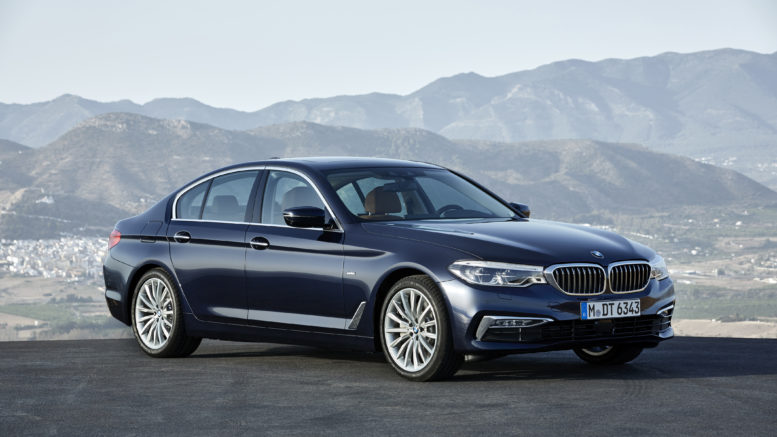

Be the first to comment on "2017 BMW 5-Series Sedan/Saloon Review: offers more than expected"